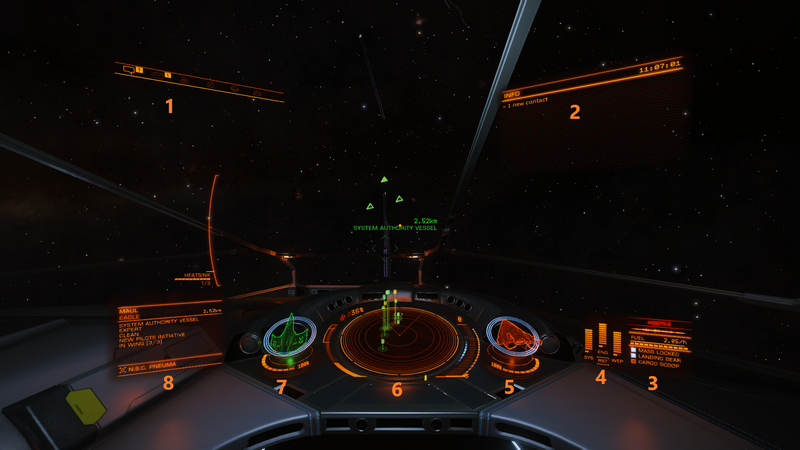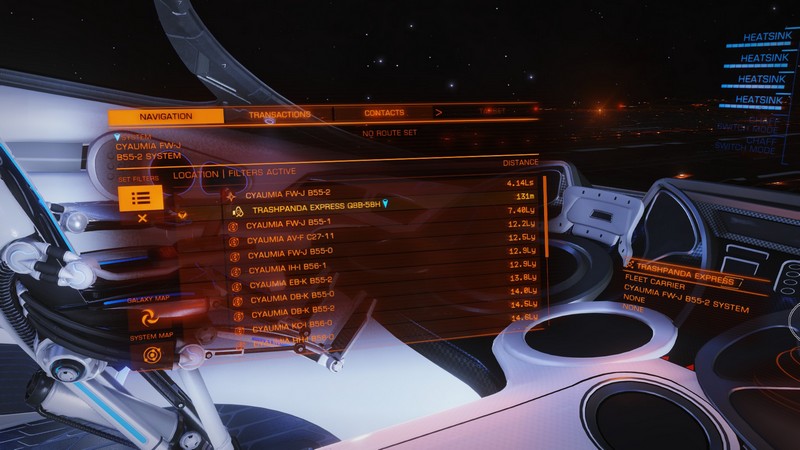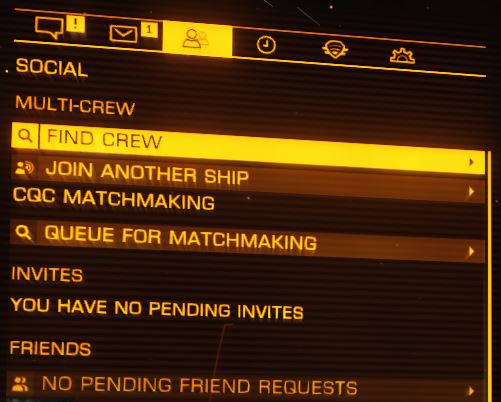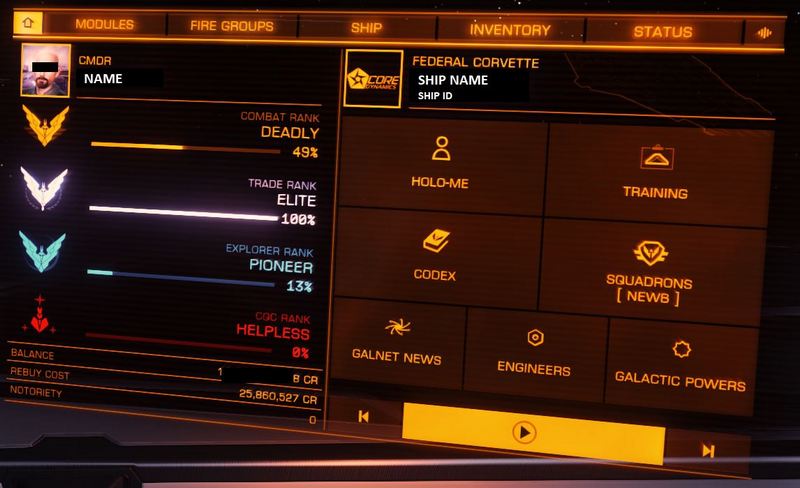HUD and ship menus
Table of Contents
Introduction
Ship hud and the different menus can be quite overwhelming at first, but getting familiar and quickly navigating between the menus is of utmost importance and a thing of habit. Here you will find a guide for the hud and all other menus, take the time to familirize yourself with the different menus and options.
This cannot be stressed enough, but when you find yourself in a tough spot - quickly selecting an escape vector or restarting a module might be a real lifesaver.
Main ship hud
This is the hud of the ship itself, you will spend most of the time looking at this. The different components are numbered so we can discuss each one:

This is the communication (comms) panel. We will go over this in more detail in the next section but here you can chat with other commanders in game, read mission related messages, see your in-game friends, accept friend and wing requests.
This is the info panel. Here you can find the game clock, it is specifiying the current game time (GMT) which is also UTC (or GMT+0) in real life. Under the clock, you can see any new contacts your sensors have found, or important ship messages and alerts.
Here you can find the following:
- Your status with power play faction (you can see here a Hostile status).
- Just under the status there is a line that resembles a sound wave - this is your ships signature (the amount of "noise" your ship emits), the more power and heat - the stronger the signature. Strong signature means others can lock on you from further distance.
- Your fuel consumption and reserve (that rectangled line). When you plot a hyperjump into another system you will note the amount fuel that will be used marked in blue on that line.
- Mass lock indicator - this means you cannot engage your Frame Shift Drive (FSD) because the gravitational pull from a nearby object prevents you from doing so. You will need to move further away (~5km away).
- Landing gear indicator - indicates whether your landing gear is deployed.
- Cargo scoop indicator - indicates whether your cargo scoop is deployed.
PIPs - One of your ship modules is called the Power Distributor. It allows you to manage the power in your ship according to your needs. Here you can see the your current power charge in the capacitors and indication your current power distribution where:
- SYS is systems which controls shield strength.
- ENG is engines which controls thruster output.
- WEP is weapons which supplies power to weapon modules.
- RST will reset your current preset to default (which is 2 to each or 2-2-2).
Shields and hull - The 3 rings around your ship are your shields. Once your shields go down, any damage will affect your hull, which is indicated here by the percentage and the bar below your ship silhouette.
Radar - this indicator has 3 very important componenets:
- Speed - on the right if the radar you can see your ships speed indicator. The blue section in the middle is the optimal turn rate indicator.
- Radar - this is the ships radar itself, here you can see other objects in your vicinity. Under the radar you have a small rectangle, this is your radar zoom and you can map it to a control in order to change it when required.
- Full indicators are NPCs while hollow are other players.
- Green are your faction, yellow are other factions, red are enemy.
- Rectangle is a ship, triangle are a ship with it's hardpoints deployed. The radar is a 3D representation, so if the object is above or below you, you will see it as such.
- Heat - on the left of the radar you can see your ships heat indicator. Almost everything that you do affects the ships heat (charging FSD, firing weapons, fuel scooping etc.). Keep an eye on this one as once you go over 100% heat your ship will start getting damage.
Locked target - Same as with your ship indicator on the right side here you can see the shields and hull for your locked target. This is very important during combat.
Locked target and location info panel - Here you can see details about your locked target such as: name, ship, distance, allegiance. If you are not locked on anyone it will show general system info like system, planet or station name.
Navigation panel
The navigation panel (nav panel) is one of the main menus you will use in the game. Aside from using the galaxy and system map, this is how you find assets within a system, see your active missions and their details, request docking and sub-target your targets modules.

There are 4 tabs in the menu:
Navigation
- Right under the tabs you can find the details of system you are currently in. When plotting a jump to another system you will see here the destination system name and the amount of jumps planned for the route.
- On the left side of the panel you will find 3 buttons:
- Set filters - to filter asset types in the nav panel within the system.
- Galaxy map - where you can plot a route between systems (It is highly recommended to assign a dedicated keybind for this!).
- System map - where you can see current system, assets and their details in a system you are currently in (It is highly recommended to assign a dedicated keybind for this!).
- The main table shows assets within the system, their distance and at the bottom the closest systems to the current one.
Transactions - in this tab you will find missions that are currently active, bounties and war bonds that you have earned as well as any outstanding fines against you.
Contacts - here you can see all contacts in the vicinity of your ship, as well as any stations or fleet carriers where you request docking from this tab.
Target - this is the subtarget tab, when you are locked on a target you will be able to see it's modules and target each individual module here.
Communication panel
The communication panel consists of 6 tabs, we will go over them left to right:

Chat - messages from NPCs which is very useful as you will get such a message before you will be interdicted by an NPC in game. You can also chat with other commnaders in game, whether in the system, squadron, wing or direct message.
Inbox - messages about your missions and related NPCs as well as some system messages (like powerplay cycle or fleet carrier weekly charges for example).
Social - friends requests and invites for wings, here you can also check whether your in-game friends are online and their location.
History - a list of player commanders you are or been in vicinity.
Squadron Feed - news and announcements of your squadron.
Incoming Text Channels - settings for the communication panel where you can set which and how the features will work.
Ship panel
Ship panel is one of the biggest menus in the game with many sub menus and options, we will cover a few main ones only. It is highly advised to get yourself familiar with these sub menus. This panel consists of 7 tabs which we will cover left to right. Note that we will not go into the details of every one of these tabs.

Home - on the left side of this panel you will find details of your commander such as the name, ranks, balance, current ship rebuy cost and notoriety. On the left side you will see the ship type, name and ID. Below this you will see the different sub menus such as the engineers, power play, squadron, news etc...
Modules - this is where you can see which modules are installed in your ship and most importantly control which modules are active and their priority. On the bottom part you can find the power consumption bars where you can see how much power will be consumed with active modules and with deployed hardpoints.
Fire Groups - for each ship you jump into, you would need to set up the proper fire groups whether for the different sensors or different weapons. You will of course need to consider things like weapon types, hardpoint locations and even the power consumption in some cases when doing so.
Ship - ship settings and options.
Inventory - here you can see your cargo, passangers and materials you have collected.
Status - your reputation and status with minor factions and major powers.
Galnet radio - here you can listen to galnet news and radio.